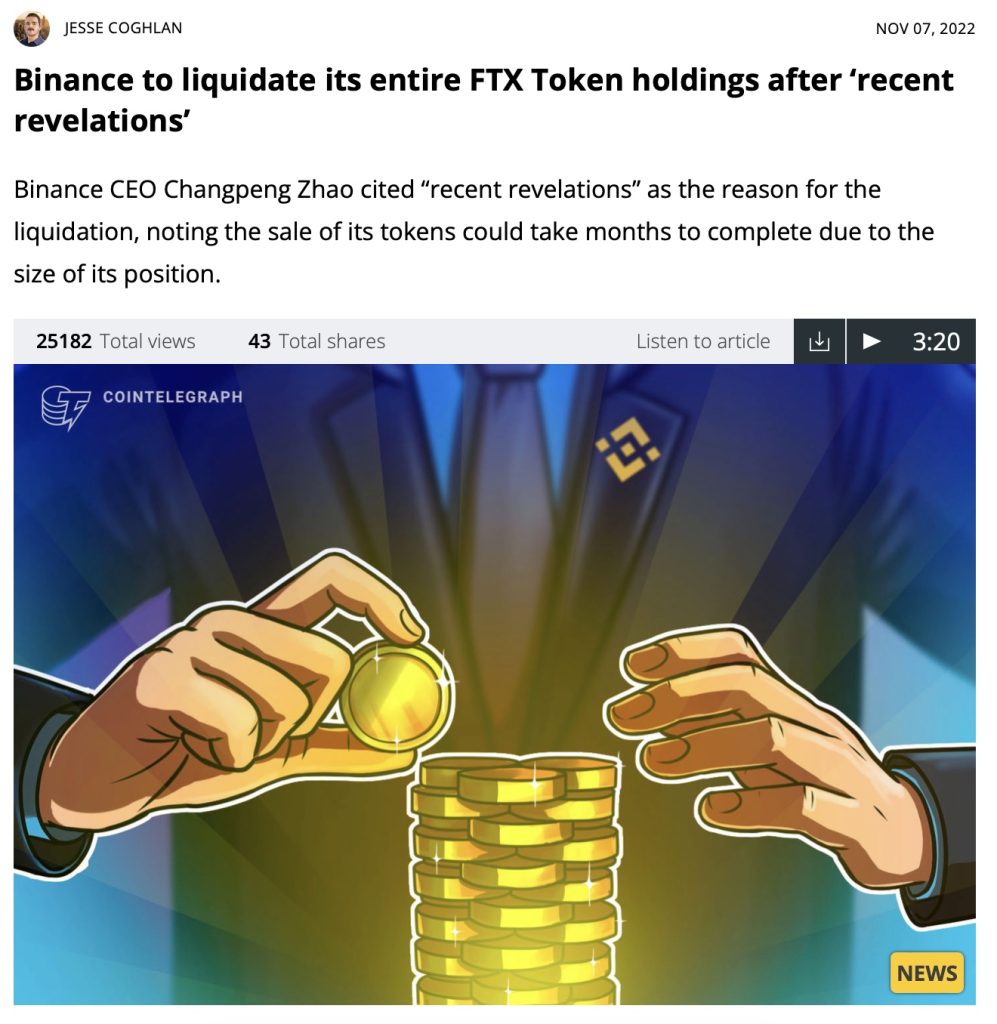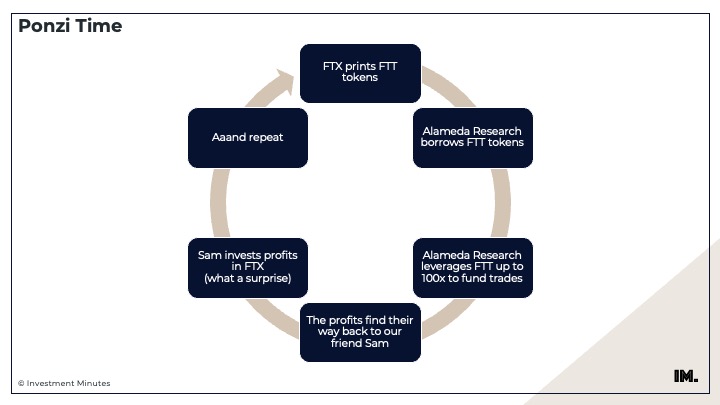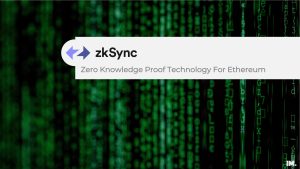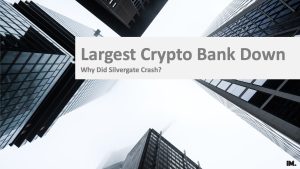This FTX Crash Is Just The Beginning
This story is my attempt at summarizing what went down with what once was the world’s second-largest crypto exchange for both private individuals and professional traders and investors.
Being 24/7 in this market, for me it sounds almost impossible this news didn’t spread wide and loud. But this weekend I took a break from crypto news and work after the shitshow following up the crash, and that gave a me a new perspective outside of this turmoil the crypto market is right now.
So this article is for those of you who might have not heard of FTX, its crash, and might not be aware of the consequences and opportunities that this brings with it. Maybe also for the cryptonians like me who are looking for a fresh take on the crypto soap.
Let me start by the very beginning of this story. November 2, 2022.
The Companies & People Behind FTX And Its Crash
FTX – The crypto exchange, the world’s second-largest, known for its extremely low transactions and trading fees, specialized in a broad selection of financial products in the crypto space.
Alameda Research – The (proprietary) trading company specialized in crypto assets founded and run by FTX’s CEO Sam Bankman-Fried.
Sam Bankman-Fried – Founder, CEO of FTX and (admittedly) Alameda Research. Also known as SBF.
Caroline Ellison – CEO of Alameda Research.
Changpeng Zhou – CEO of Binance (the world’s largest crypto exchange as of this article).
A Look At FTX’s & Alameda’s History
Alameda Research was founded in 2017 as a trader and market maker in crypto assets. The company started with what is known as arbitrage trading across different Bitcoin exchanges. This means they were profiting from price differences in Bitcoins across exchanges. In their case, across US and Japanese exchanges. The profits made by these trading activities are also known as the Kimchi Premium.
Note: most of Alameda’s capital to start trading and arbitrage activities was borrowed. This is an important details for later on.
Quickly after realizing the first Kimchi Premiums on Bitcoin arbitrage, Alameda started trading pretty much every coin on every exchange in the world. With their trading algorithm they could realise 4-5% per trade even in bearish market conditions! This sounds like a small profit. But scaled on thousands and thousands of trades, it builds up to a huge amount of profits!
Fast forward to 2019, Alameda Research became the largest market maker in the crypto space.
📞 Investment Minutes Help Line
What is a market maker? Market Makers are companies or individual in the financial market who accumulate financial products (called securities) and make them available for buy and sell transactions.
If you have ever used an investment application, you might be used to buy and sell a coin or a stock at any time. Well, market makers are the ones who provide that level of liquidity in the market by holding, buying, and selling part of their position.
FTX came in the picture in 2019, after Alameda Research had established itself as a leading market maker. What jumpstarted FTX’s growth in the market was the private sale of their own cryptocurrency called FTT (FTX Token).
FTT started off as an ERC20 token on the Ethereum Network with a total supply of 350 million tokens. It went on implementing a connection to Binance Chain as a BEP2 token. 20% of the tokens were sold during the private sale to, watch out here: Alameda Research (our friend Sam), Binance, Coinbase, and a selected group of crypto venture capital funds and business angels. FTX even managed to get a few celebrities to invest, amongst which Tom Brady. 50% was allocated to the company (again our friend Sam) and team (again our friend Sam).
Note: all tokens finished vesting in May 2022. This means that ALL tokens were available to be sold in the market. Before the end of the vesting period, not all tokens can be sold.
As you can see already, a BIG portion of FTT tokens were in the hands of the same people and organizations, namely Sam-Bankman Fried (SBF) and Alameda Research. By this time, SBF stepped off as a CEO of Alameda Research. Caroline Elliot replaced him.
A First Warning Of A Possible FTX Crash
The first warning came from this article published by CoinDesk. They pointed out that most of Alameda Research’s reserves were held in their own FTT token! I did some math after getting my hands on some (half-baked) balance sheet information. And here’s the breakdown of the assets they held in their accounts.
Asset | $ Value (Billions) | % Value |
|---|---|---|
FTT (Unlocked) | $3,66 | 38,8% |
FTT (Locked) | $0,292 | 3,1% |
FTT (Collateral) | $2,16 | 22,9% |
SOL (Unlocked) | $0,292 | 3,1% |
SOL (Locked) | $0,863 | 9,1% |
SOL (Collateral) | $0,041 | 0,4% |
Equity Securities | $2 | 21,2% |
Cash & Equivalents | $0,132 | 1,4% |
Breakdown - Alameda Research Reserve
Funny thing is, it turns out Alameda Research was already close to insolvency in 2020. The rumor is that they got a large FTT injection from FTX after the private sale. This might be the reason why their reserves are mostly held in FTT native token.
This was a positing thing as long as the market sustained growth, just like in 2021. In more turbulent waters, well, not too smart.
Let me make one thing clear, however. The fact that the reserves were in their own token is not per se the issue here. To draw a parallel with the traditional financial world, banks also keep a reserve in the country’s (fiat) currency. And in all honesty, fiat currencies (euros, dollars, and the likes of it) and crypto currencies are not too different from one another. Both invaluable as a good, but with value in itself based on an agreement. Therefore, if you believe in the long-term value of the decentralized ecosystem, you would manage crypto currencies just as traditional fiat money.
However, there are two aspects that do not make sense here:
- Collateral diversification: there is no asset other than their own token as reserve nor as collateral in their balance sheet. Traditional financial institution are under scrutiny regarding their reserve and collateral diversification to ensure they remain liquid (enough) to run operations;
- Timing: we are not yet in a market where crypto currencies are considered equal to fiat currencies. This means that not everybody is going to accept your “reserve” as a means of payment. Example? Try to pay taxes with your FTT tokens, and let me know how that goes.
This is why CoinDesk started raising awareness through their article.
The Start Of FTX Crash
All was quiet for a few days.
On November 6, 2022 I even wrote my article on the world’s largest crypto exchanges, including FTX at #2 there. You can still read the full article here.
FTX crash started on November 7 when Binance got news of Alameda’s balance sheet, started getting suspicious, and decided to liquidate their remaining FTT supply of 580 million FTT tokens since they “lost faith in their investment in FTX”. Remember, in this whole story, Changpeng Zhou (Founder and CEO at Binance) was one of the earliest investor in FTX.
In 2021, SBF bought back Binance’s share in the company. Binance got paid 1,5 billion in Binance’s stable coin BUSD, and 580 million in FTT. This happened after a fall-out between FTX and Binance, due to an alleged leak of information originating at Binance US towards FTX and FTX’s US subsidiary (FTX US).

The biggest suspicion is that FTT tokens from FTX’s supply (remember at least 50% of the entire supply) were circulating somehow back to Alameda Research and used for their trading activity. In short, a big Ponzi scheme.
📞 Investment Minutes Help Line
What is a Ponzi scheme? A Ponzi scheme is a a fraudulent scheme in which belief in the success of a (non-existent) enterprise is used to get new money invested in the company. The new money coming in is, instead, used to repay debts, old investors, or straight-up stolen by the orchestrator of such a scheme.
So here’s how it would work.
- FTX would print FTT tokens (out of the initially allocated supply)
- FTT tokens would be transferred to Alameda Research as a loan
- Alameda Research would leverage that 100x to fund their trading activities (this means that with €1 they could borrow €100 and use €101 for their investment strategy – you see it coming, don’t you?)
- The profits from Alameda Research’s trading activities would find their way back to FTX via, guess who, our friend Sam
- Sam would invest this money in FTX
- Aaaaand we repeat Step 1

With Binance selling all their FTT supply, fear started to kick-in and caused FTT price to decline in free-fall. Speculations that something rotten was going on started to spread wide.
The rumors about the very close and intricate relationship between Alameda Research and FTX were reinforced when our other friend Caroline tweeted that Alameda would happily buy back FTT at $22. This pretty much confirmed what I illustrated above.
Note: to be honest, and to hold myself to higher moral standards than our friends at FTX and Alameda, there is no full (peer-to-peer validated) on-chain proof of that scheme. There’s bits and bytes out there giving a partial picture of how money was flowing in that scheme.
With more sell pressure building up, FTT price fell dramatically to the point that both Alameda and FTX started liquidating their entire crypto portfolio to avoid liquidity problems.
A Brief Moment Of Hope Before The FTX Crash
With FTX and Alameda burdened by liquidity problems, the vultures started approaching. First in line, as old shareholder and rival exchange: our other friend Changpeng Zhou from Binance. We will call him CZ from now on.
Starting to see a conspiracy theory already? If now, HODL, I will get back to this at the end of this article.
CZ signed a non-binding offer to acquire FTX, provided due diligence. What this means is that Binance would take a look at FTX and if they didn’t find anything funky, they would buy it.
But…

… during their research, Binance found out that FTX had a $8,9 billion dollars in liquidity gap. FTX had only $900 million in “liquid” assets against $8,9 billion liabilities. And I would even question how liquid those assets were in the first place.
After that, CZ pulled out of the deal. And with that down went Alameda Research and FTX.
Conspiracy Time
Here’s the tea. Some of the stuff that does not make much sense around this crypto shitshow.
- Binance is the world’s largest exchange and was facing a lot of competition from FTX. Could FTX crash be Binance’s carefully engineer maneuver to crush their competition? After all, this all started with them selling 580 million FTT is one day!
- There is a chance that user funds were actually used for the leverage needed in Alameda’s trading activities
- On-chain data on Etherscan shows withdrawals from the Bahamas hours after withdrawals were not available to customers any longer. Is that our friend Sam and their close crew withdrawing funds to save their asses and fly to God knows where? Check Etherscan here
My Final Considerations On FTX Crash
To kick it off, I am with all the users, the average guys, traders, investors, anyone who saw their savings or investments wiped out as a consequence of this shitshow. It sucks. Please, take good care of yourselves in this period. I can only imagine the frustration if you lost your savings to this madness. But however hard, you will recover from this. Let this be a lesson on how you can manage your crypto investments well in the future and remove unnecessary dependencies from rotten organizations.
For crypto, this makes for a strong case in favor of decentralized technology, finance, and ecosystem in general.
Decentralized finance applications (DeFi) is not at all affected by this. Those protocols are actually THRIVING now that users are moving funds to decentralized wallets.
Again, if you still hold cryptos in centralized exchanges: get them out to a decentralized wallet or (even better) a custody wallet as soon as you read this message.
Regulators will be after centralized exchanges with heavy artillery. And righteously so.
Let’s hold ourselves to the highest of standards in terms of transparency and fiduciary duties.
Newsletter
Stay up-to-date with the latest developments in the stock and crypto market., fund, and crypto market.
Disclosure
These are unqualified opinions, and this newsletter, is meant for informational purposes only. It is not meant to serve as investment advice. Please consult with your investment, tax, or legal advisor, and do your own research.




No comment yet, add your voice below!